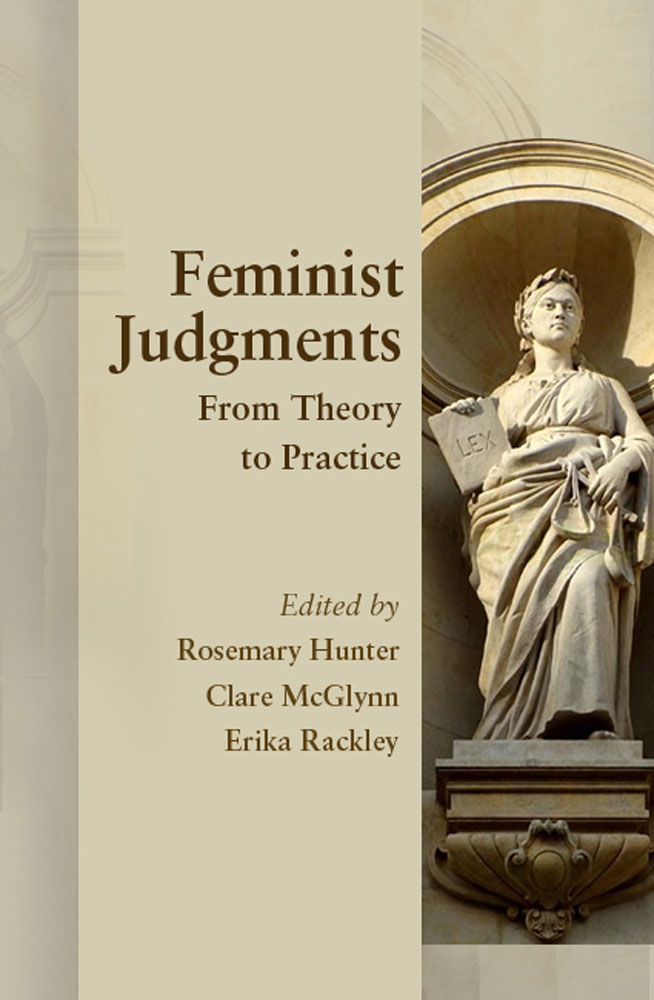 by Rosemary Hunter, Clare McGlynn, and Ericka Rackley (eds.). Hart Publishing, 2010. 504pp. Paper. £22.95/$40.00. ISBN: 9781849460538.
by Rosemary Hunter, Clare McGlynn, and Ericka Rackley (eds.). Hart Publishing, 2010. 504pp. Paper. £22.95/$40.00. ISBN: 9781849460538.Reviewed by Renee A. Pistone, Rutgers University, Faculty, The Writing Program and Fellow, Harvard Ukrainian Research Institute. Email: rpistone [at] fas.harvard.edu.
pp. 16-17
Feminist Judgments is a work that strives to move from "theory to practice." Feminist legal scholars, and a judge or two, analyze decided cases, writing opinions from a feminist perspective to show what feminist theory would look like if practiced in courts. Not surprisingly it puts forth alternative legal conclusions and rulings that many in the world of law would consider radical.
The whole notion of moving from “theory to practice” describes the book’s focus. It serves as a guide for judges to properly carry out rulings that are more consistent with feminism as the scholars involved with the Project re-write the rulings that would be more consistent with their aims. Part I provides readers with an introduction to the Feminist Judgments Project which analyzes the relevant cases from the: United Kingdom; Australia; Canada; South Africa; United States; European Court of Human Rights and European Commission of Human Rights; European Court of Justice; and the International Court of Justice. There is a comprehensive table of statutes and details about legislation which directly corresponds with the cases studied.
The title suggests that feminist judges are called on to do even more in order to advance their respective causes, and others are called on to expand their thinking about the possibilities of law. In the introduction, the legal scholars write, “the central issue debated in the literature is the extent to which judges ‘make’ as opposed to ‘find’ the law and what resources they draw upon, or ought to draw upon, in so doing” (p.5). The English court cases that are featured are directly relevant to their goals, and their theoretical revisionist rulings would make for interesting case law in practice anywhere in the world.
On the one hand, feminist scholars have argued that women enhance professional roles as they seek to make more interpersonal connections through collaborative efforts (Gilligan, 1982). On the other hand, other feminists have advised that the subordination of any woman should be of primary concern to all women (MacKinnon, 1985). This book calls for judicial activism and seeks the activist judge to act alone in convincing other judges of a specific viewpoint in order to reach a majority in the particular decision. The cases are prominently featured within the chapters that are organized and well developed by topic and area of law: parenting; property and markets; criminal law and evidence; public law and equality. In nearly two dozen opinions, some written as concurring or dissenting opinions and some as fictitious appeals, illustrate alternative paths of the law. [*17]
In the introduction, the editors introduce the Feminist Judgments Project, which is made up of a collective of scholars that share a common mission embodied in the following: “impatient with the glacial progress made to date in appointing women to the judiciary, and skeptical of the capacity of the conservative efforts put in place to address women’s under-representation to achieve much more than tokenistic change, we decided, quite literally to take the law into our own hands” (p.8). Clearly, this book serves as an urgent call for changes in the law; it asks these feminist judges to evaluate their own performances and to ascertain what more they can do to join them in solidarity, adhering to their mantra to “change the law and not turn our backs on it” (p.8). The forward, written by Baroness Hale of Richmond, represents one particular feminist Judge who answered their call and has been awakened to new possibilities as a result of this book. Lady Hale, an unconventional trailblazer, is the first and most senior female judge in the United Kingdom and many of her cases are featured throughout this book directly and indirectly scrutinized. The book tacitly seems to suggest additional advice for Lady Hale, and others, to pursue alternative courses of action in future cases.
It is also posited here that women in positions of power and influence should use that prestige to consider a woman’s particular circumstances and to go to extremes to help other women. What the scholars may take for granted is that there is only so much help that the feminist judge may render. In fact, most training programs (approved by feminist organizations) strive for female judges to work solely toward ensuring that vulnerable female witnesses are treated ethically (Rhode, 1994). In the introduction, Hunter, McGlynn, and Rackley muse, “we want to tackle law’s understanding of rape directly, so that when a woman says, ‘I was raped,’ the law says, ‘I believe you’” (p. 9).
The most important dimension of this work is that it depicts how the law has traditionally protected and even favored male rights. In short, we learn that a feminist judge should target specific facts (consistent with feminist principles) within a case and place more emphasis on those facts. In this manner, we see how feminist judges think differently and may achieve their own professional ends in a manner that is likely distinct from other judges. In doing so, the contributors have authored revised legal opinions that do not always consider that judges often work collegially, and have to build a consensus.
REFERENCES:
Gilligan, Carol.1993. In a Different Voice: Psychological Theory and Women’s Development. Cambridge: Harvard University Press.
MacKinnon, Catherine. 1985. “Feminist Discourse, Moral Values, and the Law: A Conversation,” 34 Buffalo Law Review 11.
Rhode, Deborah.1994. “Gender and Professional Roles,” 63 Fordham Law Review 39.
© Copyright 2011 by the author, Renee A. Pistone.